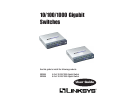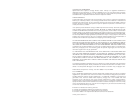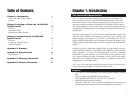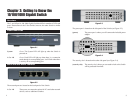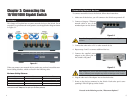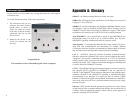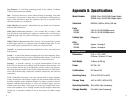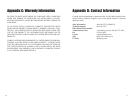
9
Appendix B: Specifications
Model Number SD2005 5-Port 10/100/1000 Gigabit Switch
SD2008 8-Port 10/100/1000 Gigabit Switch
Standards IEEE 802.3, 802.3u, 802.3x, 802.3ab
Ports
SD2005 5 RJ-45, 10/100/1000Mbps ports
SD2008 8 RJ-45, 10/100/1000Mbps ports
Cabling Type Category 5e
LEDs
SD2005 System, 1 through 5
SD2008 System, 1 through 8
Dimensions 5.12" x 1.18" x 5.00"
(130 mm x 30 mm x 127 mm)
Unit Weight 14.99 oz. (0.425 kg)
Power DC 12V, 1.5 A
Certifications FCC Class B, CE
Operating Temp. 32ºF to 122ºF (0ºC to 50ºC)
Storage Temp. -40ºF to 158ºF (-40ºC to 70ºC)
Operating Humidity 20% to 95%, Non-Condensing
Storage Humidity 5% to 90%, Non-Condensing
8
Fast Ethernet - A 100 Mbps technology based on the 10Base-T Ethernet
CSMA/CD network access method.
Hub - The device that serves as the central location for attaching wires from
workstations. Can be passive, where there is no amplification of the signals; or
active, where the hubs are used like repeaters to provide an extension of the
cable that connects to a workstation.
Mbps (Megabits per second) - One million bits per second; unit of measure-
ment for data transmission.
MDI (Medium Dependent Interface) - On a network hub or switch, a MDI
port, also known as an uplink port, connects to another hub or switch using a
straight-through cable. To connect a MDI port to a computer, use a crossover
cable.
MDI-X (Medium Dependent Interface Crossed) - On a network hub or switch,
a MDI-X port connects to a computer using a straight-through cable. To con-
nect a MDI-X port to another hub or switch, use a crossover cable.
Network - A system that transmits any combination of voice, video and/or data
between users.
Switch - 1. A data switch connects computing devices to host computers, allow-
ing a large number of devices to share a limited number of ports. 2. A device for
making, breaking, or changing the connections in an electrical circuit.
Topology - A network’s topology is a logical characterization of how the
devices on the network are connected and the distances between them. The
most common network devices include hubs, switches, routers, and gateways.
Most large networks contain several levels of interconnection, the most impor-
tant of which include edge connections, backbone connections, and wide-area
connections.
UTP - Unshielded twisted pair is the most common kind of copper telephone
wiring. Twisted pair is the ordinary copper wire that connects home and many
business computers to the telephone company. To reduce crosstalk or electro-
magnetic induction between pairs of wires, two insulated copper wires are
twisted around each other. Each signal on twisted pair requires both wires.
Since some telephone sets or desktop locations require multiple connections,
twisted pair is sometimes installed in two or more pairs, all within a single
cable.
Environmental



